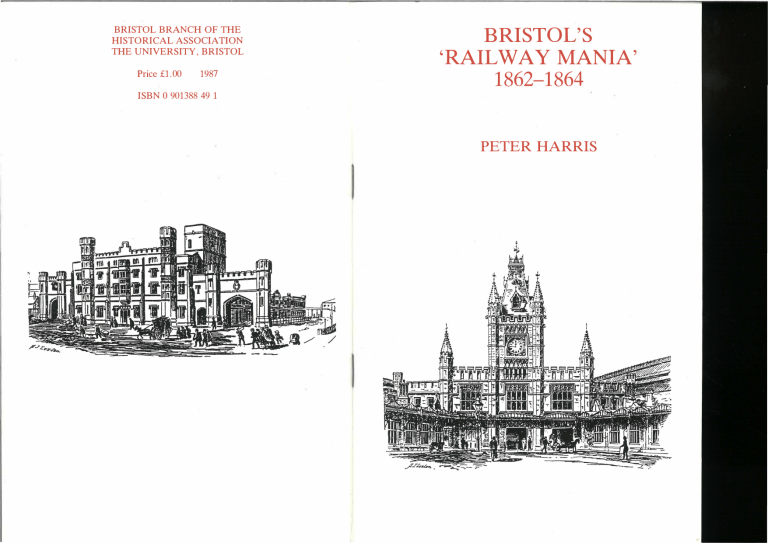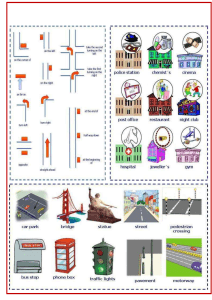
BRISTOL BRANCH OF THE
HISTORICAL ASSOCIATION
THE UNIVERSITY, BRISTOL
Price £1.00
1987
BRISTOL'S
'RAILWAY MANIA'
1862-1864
ISBN O 901388 49 1
PETER HARRIS
BRISTOL BRANCH OF THE HISTORICAL ASSOCIATION
LOCAL HISTORY PAMPHLETS
Hon. General Editor:
Assistant General Editor:
PATRICK McGRATH
PETER HARRIS
Bristol's 'Railway Mania', 1862-1864 is the sixty-sixth pamphlet
to be published by the Bristol Branch of the Historical Associ­
ation. Its author, Peter Harris is national chairman of the Local
History Committee of the Historical Association and a former
Deputy President of the Association. He is Area Adviser for
Gloucestershire and Avon as well as Honorary Secretary of the
Bristol Branch. It was at his suggestion that this series of pam­
phlets was started in 1960, and his energy and enthusiasm as
Honorary Assistant Editor and as Business Manager have made it
possible for the series to flourish over the last twenty-seven years.
The illustration on the front cover shows the new Temple Meads
Station of 1880. The back cover shows the original Great Western
Railway offices on Bath Parade.
The next pamphlet in the series will be The Bristol Gas Industry
1815-1949 by Dr Harold Nabbs.
The Pamphlet Appeal Fund, which is designed to put the series
on a sound financial basis, is still open, and readers are invited to
contribute. Donations should be sent to Peter Harris, 74 Bell Barn
Road, Stoke Bishop, Bristol BS9 2DG. Cheques should be made
payable to the Bristol Branch of the Historical Association.
A list of pamphlets still in print is given on the inside back cover.
Copies can be obtained from most Bristol booksellers, from the
shop in the City Museum, from the Porter's Lodge in the Wills
Memorial Building, or direct from Peter Harris.
© Peter Harris
ISBN O 901388 49 1
CLASS
No.
L 4--0 · O:l
ALLOC.
1 1/l lllli�I 11/l1it1l1illIj
BRISTOL'S 'RAILWAY MANIA'.
It is not always an advantage to be first in any major
technological advance. Bristol was in the vanguard of railway
construction when, in 1834, its citizens promoted the building of a
railway from Bristol to London. When the Great Western Railway
was opened it had a splendid terminus at Temple Meads, but time
was to show the inconvenience of its situation and a number of
attempts were made later to bring the railway into the heart of the
city.
In 1840 few people realised all the implications that the building
of a railway station would have for a large provincial city. In
Bristol Brunel chose Temple Meads as the site of his terminus
because it was the nearest piece of open land to the centre of the
city if the approach route of the railway was to be along the valley
of the river Avon. The station was just outside the old extended
city walls with Temple Gate adjacent to the frontage of the offices.
Earlier proposals had envisaged a terminus near Old Market and
in 1835 Brunel stated that the Great Western Railway could have
been carried across Pill Street and Queen Square, but in the event
the area round Temple Meads was chosen because it was so
sparsely populated and there was no need to displace many
householders when the station was built. As it happened, much of
the property between the station and Bristol Bridge was in fact
demolished in the 1870's, but by then, of course, it was too late to
bring the terminus nearer to the city.
When deciding on the position of the terminus for the Great
Western Railway, Brunel does not seem to have considered any
connection with the Bristol and Exeter Railway whose terminus
was to be only a short distance away. As he was the engineer for
1
The site of Temple Meads Station as shown on Parliamentary Plan,
1834
By courtesy of Bristol Record Office
houses lined Bath Parade while the northern edge of the property
was still being used as a rope-walk.
The building which Brunel erected on this plot is unique in
railway history. It was intended to be a ' comprehensive railway
building' containing most of the services necessary for running a
railway. At the track level there were separate arrival and
departure platforms with five lines of track between them. The
station section was covered by an overall roof with rooflights over
the platforms. Beyond this section was as extension of the carriage
shed with a much lower roof. Trains which had just arrived were
drawn into this section and the engine was switched to another
track by a movable set of rails called a 'sector table' which was
built at the far end of the station. The engine was then free to leave
the station by another track. The carriages were transferred to
other tracks where they were prepared for their next journey. In
the office block which faced on Bath Parade, there was an
impressive Boardroom for the Directors with an equally impress­
ive office adjoining if for the company secretary. There were other
offices connected with the administration of the railway, and over
the extension of the carriage shed was a drawing office for the
engineers. There were two large strongrooms built into the offices.
There were also domestic quarters for the Company Clerk who
resided in the building. As the whole station was built on arches,
these were used for storage and stabling.
The goods station was to the north of building and at a lower
level. The only services not available on this site were the engine
sheds and the coke ovens which were some short distance along
the line towards Bath.
The station was intended for the use of first and second class
passengers. When Parliament decreed that third class passengers
must be carried, they joined the train at a point outside the station.
The station was very definitely a terminus. By building the office
block across the end of the tracks Brunel made it impossible to
convert it into a through station, a fact which must have annoyed
future generations of railway planners.
The Bristol and Exeter Railway Company also built its station
on Temple Meads, adjacent to but at right angles to the Great
Western Station. Shortly after the railway opened, the bridge
carrying the Great Western over the Floating Harbour was
widened to carry an extra pair of tracks. These curved round the
edge of the cattlemarket to form a direct connection with the
Bristol and Exeter line. The shape of this curve was to dictate the
2
3
both lines, presumably planning for both was proceeding simulta­
neously, and this lack of foresight is surprising. It would seem that
the two Boards of Directors wished to have separate stations and
buildings which would emphasise the prosperity of their com­
panies.
The plan of the site of Temple Meads [fig 1] shows that the land
was still open and used for grazing. An assortment of sheds and
Wl
present shape of the station. A platform was built by the Bristol
and Exeter Company known as the 'Express Platform'. Here all
through trains from London to the West of England stopped to
pick up and put down passengers. The Great Western station was
used for trains from London and Gloucester which terminated
there. [Fig 2].
After all this it is surprising how little Bristol was affected by the
spate of railway promotions of the mid-1840's. The period 1844-47
is often referred to in English History as the 'Railway Mania'.
During these years hundreds of proposals for new railways were
made. In 1845 there were 620 schemes proposed, which, if
constructed, would have cost £563,203,000. In 1846 there were
another 369 schemes for England and Wales which could have cost
another £184,000,000.
One area of calm in this storm of speculation was Bristol. Only
five Bills were submitted to Parliament during this period which
affected the city. They were:
1844 A Bristol and Exeter Railway Company Bill which included
the branch line from Yatton to Clevedon.
1845 The Bristol and South Wales Junction Railway from
Temple Meads to New Passage.
1845 The Portbury Pier and Railway. This was to be a line to
Portishead via a tunnel under Failand. From the plan it
appears that Brunel thought that it might be a suitable line
for the use of the Atmospheric system of locomotion.
1845 The Dover and Bristol Railway - proposing a line from
Bristol to Queen Charlton. This was the most speculative
proposal.
1846 The Bristol and Poole Harbour Railway - Routed via
Knowle, Clutton, Radstock, Shepton Mallet, Blandford,
Corfe and Poole Harbour.
PLAN OF THE BRISTOL STATIONS, 1845
4
This limited interest in the Railway Mania may have been
because in the eighteen forties the investors of Bristol felt that the
city's railway needs were adequately served by the existing lines.
The G.W.R. provided a link with London and the major cities to
the east. The Bristol and Gloucester was the way to the Midlands
and the North. The first section of this line had opened from
Mangotsfield to Bristol in August 1835, a few weeks before the
G.W.R. bill was approved. The line was extended to Gloucester
and, by a series of complicated arrangements with the G.W.R., it
was agreed to alter the gauge from 4 feet 8½ inches to the broad
gauge of 7 feet. This was mainly at the insistence of Brunel. The
result of this was the notorious scene of chaos at Gloucester where
passengers from Bristol who were travelling on to the Midlands
5
had to leave their broad gauge train and cross the platform to
board a standard gauge train to Birmingham. While this worked
reasonably well for passengers, luggage and goods were always
going astray in the changeover. Gloucester was also important
because it marked the junction with the lines to South Wales.
The link with the West of England was the Bristol and Exeter
Railway which in its early years was operated by the Great
Western Railway. The line from Bristol to the West left the city by
a route which was reasonably level. The line to Gloucester had a
steady climb to Fishponds but was probably the easiest route north
from the city. What Bristol did not have was a direct route to the
South coast [hence the projected Bristol and Poole Harbour line of
1845].
It is likely that many Bristolians participated in the great
scramble to get rich in the eighteen-forties and some may have lost
their savings when the railway bubble finally burst.
Bristol's railway mania occurred in the 1860's. There were
several reasons, but the most obvious one was the position of
Temple Meads Station as the principal station for the city. At this
time the main traffic carried by the railway was passengers and first
and second class passengers at that. Third class travellers were
something which had been forced on the Railway Companies by
the 1844 Act and were not to be encouraged. Goods traffic did not
figure largely in the revenue of the Great Western Company until
the end of this decade.
This meant that most of the potential passengers were wealthy
business men and citizens of the city. By the 1860's many of them
were moving from the centre of the city to the more salubrious
areas of Redland and Clifton. To reach Temple Meads from these
suburbs meant a journey by cab or on foot to the centre of the city
where they would cross the River Frome by the Drawbridge and
continue by way of Clare Street to Baldwin Street and Bristol
Bridge. [Baldwin Street did not run directly from the Drawbridge
to Bristol Bridge until 1881]. In 1860 Bristol Bridge was much
narrower than it is today but an extra eleven feet were added in
1861 by building the footpaths out from the sides of the bridge.
After crossing the bridge, the traveller turned sharp left into
Bath Street and then went along Temple Street to Bath Parade.
According to contemporary accounts, these two streets consisted
of 'mean and dirty dwellings' and the roads themselves were
narrow and muddy. It was to avoid this part of the journey that
people looked for an alternative site for a station which should be
closer to the city centre.
At this time, too, the city docks were becoming more prosper­
ous as a result of the new policy which the Docks Committee
adopted in 1858. This policy was to improve the docks in the city
rather than build new ones at the mouth of Avon'. However, there
was no direct railway access to the docks. All goods unloaded from
ships for transit by rail had to be loaded into carts at the quayside
and carried to the goods station. There was a small dock adjacent
to the Great Western goods shed but as it was upstream of Bristol
Bridge, it was useless for sea-going ships and only river boats could
use it.
It was partly to remedy these deficiencies that a string of railway
Bills were promoted in the early 1860s.
In 1860 the North Somerset Railway Bill was sent to parliament.
It was for the construction of a line from St Phillips on the Midland
line [as the Bristol and Gloucester railway had been aquired by the
Midland Railway in 1845] to join the Somerset Central Railway at
Wells. There were to be branches to Fishponds, Radstock and
Camerton.
1861 saw three major bills. The first was the Bristol Port
Railway and Pier Bill which was for the construction of a line
alongside the river Avon from a point at Hotwells just below the
Suspension Bridge to Avonmouth. From the Hotwells terminus to
Sea Mills it followed roughly the present Partway and the railway
line. A pier was to be built at Avonmouth to allow passengers to
board ships which could not or would not sail up the Avon.
The second bill was for the Bristol and South Western Junction
Railway and this was a modified plan for the North Somerset
Railway. Instead of using the Midland Railway station at St
Phillips, it proposed to build a new station on the site of the Cattle
Market Yard, adjacent to the G.W.R. and the Bristol and Exeter
stations at Temple Meads. The rest of the proposed route was as in
the 1860 bill except that it would join the Dorset Central
Railway at Wincanton.
The third bill appeared to be a very modest one - an extension
to the Bristol and South Wales Union Railway from New Passage
to Avonmouth. The original Bill for the Bristol and South Wales
Union Railway had received the Royal assent in 1857 and this
enabled a line to built from just outside Temple Meads station to
New Passage. Designed by Brunel, it was the first major change in
the local railway scene for many years. Passengers for South Wales
could travel from Bristol to New Passage where the line ran along
6
7
a pier out into the River Severn. Here they transferred from the
train to a steam ferry which carried them across the river to a
corresponding pier at Portskewett where they boarded another
train to carry them to Newport and Cardiff. The line opened on 8
September 1863 and was operated by the Great yv-estern Railway.
It did not provide an easy route to Wales, the ferry boats were
unreliable, the voyage was often rough and travellers might find
themselves stranded and spending the night in the New Passage
Hotel. However, this bill of 1861 was to provide the first link
between the main railway system and Avonmouth.
Then in 1862 came the first of a series of schemes which, it was
hoped, would improve the railway facilities in the city itself. This
was the Bristol and Clifton Railway Bill. The line was intended to
fill two needs. Firstly, it was intended to link Temple Meads with a
station in Clifton. From a junction to the east of Temple Meads
the new line would pass alongside the station to cross Bath Parade
on a bridge and then proceed through Redcliffe on a series of
arches. It would cross the river Avon on a lifting bridge at about
the site of the present road bridge. It would then cross the
southern side of Queen Square [parallel to the Grove] on arches
and a low embankment. The embankment would also support a
passenger station to serve Queen Square. A viaduct would carry
the track across Prince Street before crossing St Augustines Reach
on another movable bridge. This would allow ships to sail up the
Frame to Quayhead. The track would continue along the line of
Anchor Road before crossing St Georges Road to a terminus just
below the site of the old Police Station on Brandon Hill. The
second function of the line was to provide a rail link with the City
Docks. From the Prince Street side of the bridge over St
Augustines Reach a network of tramways were to cover many of
the quays around the Floating Harbour. Goods could then be
unloaded directly from the ships into railway wagons and sent by
rail to their destinations.
The directors of the Company which put forward this bill were
some of the most distinguished men in the city - Philip Skinner
Miles of Penpole House, William Harford the younger, James
Bush, member of the Docks Committee 1858-1866, Handel
Cosham of Shortwood Lodge, John Bates of Royal York Cre­
scent, another member of the Docks Committee 1860-1861,
Francis Kentucky Barnes, timber importer, William Killigrew
Wait, grain merchant and owner of the Granary on the Welsh
Back and Mark Whitwell of the ships chandlers in the Grove.
8
9
The solicitors for the Company were Brice and Burgess and the
office of the Company was at 52 Queen Square. The Engineer in
Chief was John Fowler with Charles Richardson, who was well
known in local railway circles, as his assistant. The capital required
for the construction of the line was estimated to be £250,000. Of
this sum the Great Western Railway offered to provide half the
amount and the other half as a loan at 4%. As the G.W.R. would
be the majority shareholders the line would be constructed for the
broad gauge.
The reaction of the citizens to this proposal seems to have been
mixed. The more influential bodies in the city like the Merchant
Venturers and the Chamber of Commerce welcomed the scheme.
A memorial in favour of the line was received by the City Council,
signed by 5144 owners of property within the city. A counter
petition, opposing the line, was.signed by 1970 merchants, traders
and shipmasters. According to Latimer there was strong opposi­
tion to the Bill from a number of influential members of the
Council who suggested that scheme would 'divert the commerce of
Bristol from the city'. Various procedural moves were made to
prevent the Council supporting the Bill and, when the Parlia­
mentary Committee of the Council recommended that the Bill
should pass, Alderman Ford [the owner of extensive warehouses]
called the supporters of the scheme 'traitors to their native city'.
Other objections to the Bill came from a variety of sources. The
washerwomen who lived around Brandon Hill used the slopes for
drying their washing and feared that the building of the station
would deprive them of this right. Residents of Queen Square
complained that they would lose their 'rights of enjoying Queen
Square'. A similar complaint came from property owners who
lived near Brandon Hill.
Eventually the Bill went forward to Parliament where the
opposition was maintained before the Select Committee.
The route of the line was inspected by Col. Yolland, R.E. of the
Railway Department of the Board of Trade. The tour was made
on foot but the sites of the river crossings were also inspected from
a tug specially chartered for the occasion.
According to the Colonel's report there were three main
objections to the projected route:1. Low bridges over three main streets at the entrance to the city
would hinder the passage of road vehicles.
2. The opening bridges over the arms of the Floating Harbour
would be dangerous to shipping in bad weather and sparks
from passing locomotives could increase the risk of fires on the
dockside.
3. The benefits of such a line could be obtained by the presenta­
tion of a better Bill at a future date.
A number of suggestions were made, presumably to be incor­
porated in a 'better Bill'. Steam locomotives should not be used on
the Quayside tramways. As the quays were of varying heights they
would have to be made up to a standard height. The Harbour
Master would control the opening of the bridges and. the Bristol
and Exeter Railway and the Midland Railway were also to be
allowed to use the line. The section across Queens Square should
be supported by a lattice girder viaduct on cast iron columns
except for the station which would be on a solid embankment.
The Bill failed to survive the Committee stage at Westminster
and this particular project was lost as was the £12,000 for the
parliamentary expenses.
There would have been serious drawbacks to the scheme had it
been completed. The new line would have created an alternative
terminus to Temple Meads at Brandon Hill. Trains to and from
London would have by-passed Temple Meads while trains to and
from Exeter would have needed to reverse at the eastern end of
the station to reach the Bristol and Clifton line. Also the Midland
Railway would have insisted on the track being laid to the mixed
gauge. Present day conservationists may ponder on the lack of
opposition to the ruin of Queen Square, and there is no reference
to the possible effects on St Mary Redcliffe.
It was not long before a replacement Bill appeared. This was the
Bristol Central Railway Station Bill. The proposed line would
leave the G.W.R. at a point to the east of Temple Meads station
and cross the land near Midland Road to reach a point at No.60
Old Market Street. Here it would be joined by a branch line from
the Midland Railway at St Phillips before crossing Broadmead [the
plan is not very precise as to where this crossing would be]. From
there it would go by way of Rupert Street to a station which was to
built over the river Frome between Quayhead and the
Drawbridge. Whether it was intended to cover the whole area as
far as the Drawbridge is hard to discover. There is a charming
vagueness about the exact size of the station. That particular
stretch of the river Frome seems to have been used as a yard for
the storage of stone and flagstones for paving the streets. These
were brought up river by boat and stored there until required. The
station would not be occupying valuable quayspace which had
10
11
•
•• •
••• ••••
•• •
••
••
••
• •
. • . . . • "'"\.
• • •
•
L1Nf j,o
•: " • •
M_ IPLPrl-lJ:>
...,._,ff
••. Lu,,e To >(('-cw• • • SOM.ERSE.T
R.1'-t.
:
been one of the main objections to the Bristol and Clifton scheme.
The proposal was supported by a provisional committee headed
by the Hon. Henry Fitzhardinge Berkeley, MP for Bristol,
together with W.H. Gore Langton, the other Bristol MP. There
was an impressive list of other local gentlemen to, support the two
MPs. The capital required was estimated as £300,000 to be raised
by the sale of 30,000 shares of £10 each. The initial deposit for a
share was to be £1. The engineers were Messrs. Maclean and
Stileman of 17 Great George Street, Westminster.
The Bristol and Clifton scheme had been strongly supported by
the Great Western Railway but the company was less enthusiastic
about the Central Station project. There was strong support from
the Midland Railway and from a newcomer, the North Somerset
Railway, which had been seeking a way of entering the city as well
as a site for a station. The Central Station offered it a chance to
share a station with all the other companies. The North Somerset
was having difficulty in getting its bill through Parliament as the
Great Western Railway was uneasy at the prospect of a standard
gauge line approaching Bristol from the south. It is significant that
three of the directors of the Central Station scheme were also
directors of the North Somerset Company. The North Somerset
was not too concerned about the gauge of its line. If the Great
Western were interested, then it could be built to the broad gauge.
If not, they would build it to the standard gauge and hope that the
Midland and London and South Western Railways would support
them.
The Central scheme, following so closely on the Bristol and
Clifton one, was prompted by a decision taken by the Directors of
the Great Western Railway to avoid becoming involved with any
further schemes for a central station and instead to look at ways of
enlarging and improving Temple Meads station.
The original Bill for the Bristol Central Station was withdrawn
in 1862 for lack of support but it was to reappear in a modified
form in 1863.
In November 1863 two sets of plans were deposited with the
Clerk of the Peace. The first was the modified Bristol Central
Station plan. Now, instead of terminating the line at the Central
Station, it was to continue along St Augustines Parade, across
Canons Marsh to a tunnel which would carry it under the Floating
Harbour and then under the New Cut in another tunnel before
joining the Bristol and Exeter line at Bedminster. A branch would
link up with a possible line to Portishead and another would
14
15
connect with the North Somerset Railway.
This was a much more realistic proposition in that it recognised
the need for a through station and not a terminus. It brought all
the railways serving the city into one station [except the Port
Railway and Pier which was still isolated at Hotwells]. Had this
station been built Bristol would have been in a similar position to
Birmingham with a main line station in the centre of the city.
Would the bridge over the Bristol Central Station have become as
important as the famous one at New Street Station, now incor­
porated in a modern block of shops and offices?
There is no doubt that the construction of this line would have
changed the original street plan between the Centre and Old
Market but probably no more than it was changed a hundred years
later. The most difficult engineering works on the line would have
been the tunnels under the Harbour and the New Cut. Covering
the river Frame at the Centre might have seemed a problem but by
1940 this had been done for a longer stretch of the river than the
Central Station plan had envisaged. The Cathedral would have
suffered no more from the proximity of trains than it did at the
beginning of the century when the Goods Depot at Canons Marsh
was built. The prospect of a double line of track through
Broadmead is an intriguing one.
Neither the Great Western Railway nor the Bristol and Exeter
Railway were pleased with this scheme as it would have made
Temple Meads Station redundant. The high cost of the line and
doubts as to whether the tunnels could be built led to the scheme
being dropped.
The other scheme put forward in 1863 was the Bristol Port
Extension Railway. Its directors included some who had earlier
supported the Bristol and Clifton bill and it represented the
response of the opposition party to the central station scheme. The
three main line railway companies said that they would support
this scheme.
The proposed line was to leave the Great Western main line at a
point to the east of Temple Meads station and swing northwards
across the river from the south bank of the Avon. It was then
carried over the river towards Bristol Bridge on a viaduct suppor­
ted by girders resting on the banks. When the line reached the
point where the Castle Ditch joins the river, it continued across
the centre of the city. It crossed St. Peters Street and the top of
Union Street. A station was to be built at the bottom of Christmas
Steps and the line would continue to cross Park Street and then,
16
17
skirting the edges of Brandon Hill, continue to Jacobs Wells Road
[ then known as Woodwell Lane]. The line then ran along the
lower slopes of Clifton to another station at Clifton Vale.
Presumably a tunnel was to be excavated to carry the line under
the end of Royal York Crescent. From here the line would
continue along the bank of the river to join up with the Port
Railway at its terminus below the Suspension Bridge.
The capital required for this project was estimated at £450,000,
to be raised by the sale of 24,000 £20 shares. When all the capital
had been subscribed and half had been paid up, the company
could borrow to the amount of £160,000.
The line was to be of mixed gauge and there would be two long
branches which would serve various quays in the City Docks. It
would provide a direct link with Avonmouth for trains coming
from London and the Midlands but those from Exeter and the
West would have to pass through Temple Meads station and then
reverse on to the new line.
The cost of purchasing all the property along the route was
estimated as £242,562. There was considerable opposition to the
bill. It seems likely that the corporation opposed it for political
rather than amenity reasons. There is also some doubt as to
whether it was a serious attempt to build a railway or whether it
was a ploy to block the Bristol Central Station scheme. It was
almost certainly part of the backstairs wrangling which occupied
the various groups connected with the docks. The only body which
might have welcomed the scheme would have been the Port
Railway and Pier Company which, only a few years later, was to
fall into the hands of the Receiver.
By 1864 other plans were being discussed to improve the railway
facilities and most of these were on the edge of the city rather than
in the middle. There was the plan to enlarge and improve Temple
Meads Station. This led to the Bristol Joint Station Bill of 1865
which became law in the June of that year. It authorised the
building of a new station on the Temple Meads site, the cost to be
shared by the three companies using the station. Although the
Port Extension Railway bill had been rejected and there were no
further proposals for central stations, the Great Western Railway
and the Midland Railway could not agree on the proportion of the
costs that each should bear. As a result work on the station did not
begin until 1871 and the new station was not completed until 1878.
By this date the Bristol and Exeter Railway company had become
part of the Great Western Railway and so the greater part of the
total cost was borne by the Great Western Company.
The new station was built in the Gothic style and its splendid
overall roof, Gothic tower and imposing entrance hall were
considered to be a credit to the city. From now on the station was
known as the 'Bristol Joint Station' [and so it remained until
nationalisation in 1948]. Even when completed the new station
was barely large enough to cope with the increasing volume of
passengers. All trains to Devon and Cornwall still passed through
the station as did the increasing number of trains from the North.
Delays were frequent and several minor accidents at the station
were blamed on overcrowding. The original Brunel terminus
platforms were extended and a new trainshed was built over the
extension alongside the new station. These platforms in the future
would be used more by Midland Railway trains than by Great
Western ones. The Boardroom and offices in the original building
were no longer used for their original purpose and the whole block
was taken over by the Goods Department. The imposing Bristol
and Exeter building was closer to the passenger station and so this
became the offices of the Divisional Superintendent of the Great
Western Railway.
In 1865 another development had helped to maintain Temple
Meads as the main station for the city. A proposal to build a new
street from Bristol Bridge to Bath Parade was revived. It had been
put forward in 1845 as part of a package of road improvements but
had never been carried out because of the cost and local hostility
to the scheme. The work seems to have been carried out quickly
and the cost, £46,000 was less than the estimate. Eventually this
was recovered by the sale of properties along the new street which
was called Victoria Street. This removed one of the main objec­
tions to the position of Temple Meads station.
As passenger traffic on the railways was increasing, so too was
the freight traffic. By 1867 the Goods Department of the Great
Western Railway was producing the larger part of the Company's
revenue. True, much of this was due to the South Wales coal
traffic but business over the whole system was looking up and this
increased interest in providing access to the Bristol City docks. In
1866 the Bristol Harbour Railway Act led to the construction of
the line which was carried over Victoria Street on a bridge and
under St Mary Redcliffe church in a tunnel to Wapping Wharf. By
1906 the Bristol Harbour Extension Railway extended the line
from Wapping to join the Portishead Branch at Ashton Junction.
This line was carried across the New Cut on that remarkable
18
19
double-deck swing bridge which carried the road from Cum­
berland Basin on the top deck and the railway underneath. Today
the road deck has gone and the bridge cannot be swung.
Also in 1906 an extension to the Harbour Railways provided a
link with the new Goods Shed and depot at Canons Marsh. This
was the first rail link for the quays on the north side of the river. It
meant that a swing bridge had to be built across the Junction Lock
at Hotwells and this had to remain open to docks traffic most of
the time, only closing when a train had to cross. The Depot at
Canons Marsh was the nearest point to the city centre reached by
the railway. Narrow Quay, the Grove and the Welsh Back were
never served by the railway.
Efforts to improve the local passenger service continued after
1865. The Clifton Extension Railway Act received the Royal
Assent in 1867. This was a joint effort of the Great Western
Railway, the Midland Railway and the Bristol Port Railway and
Pier company. Needless to say, the first two companies provided
most of the money. The line from Ashley Hill junction to Clifton
Down opened in October 1874 with an intermediate station at
Montpelier (Redland Station did not open until 1897]. The
completion of the Clifton Down tunnel and the connection with
the Port Railway at Sneyd Park Junction gave the first direct
connection from Temple Meads to Avonmouth. At last Clifton
had its own station. There was a junction with the Midland
Railway to Fishponds and until 3 September 1939 it was possible to
travel from Clifton Down Station to Bath via Mangotsfield. The
Portishead branch had been opened in 1867 and was originally
worked by the Bristol and Exeter Railway as a broad gauge line.
All of these lines served Temple Meads. The additional stations
which were opened on the South Wales line were intended to feed
passengers on to long distance trains rather than to act as part of a
suburban network.
The opening of the Severn Tunnel made some of the suburban
stations more important. Stapleton Road station became a junc­
tion and dealt with nearly as many trains each day as Temple
Meads. All trains to and from South Wales stopped there as well
as trains from Cardiff to Portsmouth which did not pass through
Temple Meads. Before the opening of the Severn Bridge commer­
cial travellers from Bristol who were going to work in South Wales
would catch the early morning trains from Stapleton Road and
Ashley Hill stations to Newport or Cardiff. There they would
travel up the valleys by local trains.
For most Bristolians the suburban stations were places where
one caught a train to Temple Meads, there to travel on to a distant
destination, or to catch an excursion train to Weston, Weymouth
or one of the other holiday places which were popular with
residents of the city. Most of the suburban stations did not support
much traffic between stations. Some people who lived close to the
Clifton Extension line would travel from Shirehampton and Sea
Mills to Clifton Down or Montpelier. When the Fry's chocolate
factory was moved to Keynsham a special train ran from Stapleton
Road station to Keynsham to carry workers who would otherwise
have had to move house in order to be nearer to their work.
Residents of St Anne's Park might travel to Bedminster but, by
and large, these local stations fed Temple Meads up to the time of
the Beeching closures.
Just as local stations attracted little commuter traffic, so the
railways carried only a small amount of local goods traffic. There
was still an extensive network of local carriers whose horse drawn
carts visited surrounding villages once or twice a week carrying
parcels of goods from Bristol up until 1914.
The problem of easy access to Temple Meads station still
remained after the construction of Victoria Street. There were
plenty of cabs to convey passengers to the station where they
would be set down at the top of the incline outside of the main
entrance. Passengers arriving by train found a cabstand with cabs
waiting to carry them to the city centre and Clifton.
For those who worked in the city and wished to travel daily to
Temple Meads from one of the suburban stations, it was a long
walk to Bristol Bridge and from there to an office in the central
area. The construction of a horse tram route from Bristol Bridge
to Totterdown [Three Lamps] in 1879 provided a quick and cheap
way of reaching the station. In 1881 the line was extended from
Bristol Bridge to St. Augustines Parade by way of the newly­
widened Baldwin Street. At some stage the Tramway Company
had rented the space between the old station building and the
incline and a covered shed was built here as a terminus for horse
trams from the Centre. In 1899 this route was electrified and, when
the routes were given numbers in 1913, it became the No.17 route,
Temple Meads-Tramways Centre-Hotwells. This service
continued until the mid-1930s when the Tramway Company began
to run bus services to the top of the incline from various parts of
the city suburbs. The tram service ceased and the shed was
eventually demolished, the site being used for the staff canteen
20
21
which was built during the Second World War. For most
commuters the quickest route to the Centre or Old Market was to
walk to the bottom of the incline and catch the trams or later, the
buses which went along Victoria Street.
For many who worked in the city and travelled to and fro by
train, the long trudge up the incline after a long day's work must
have seemed endless and even worse if one was late. For travellers
with luggage it was a daunting obstacle to overcome. The closure
of some local stations and the reduction in the number of stopping
trains in the 1960s emphasised the role of Temple Meads as a
station for long distance travel. In 1970 British Rail opened an
experimental station on the site of the old marshalling yard at
Stoke Gifford. Christened Bristol Parkway, it provided free
parking and an opportunity for travellers to use the express trains
on the London-South Wales route. The introduction of High
Speed trains with a journey time of 1 hour 10 minutes from
Paddington produced the first serious challenge to the position of
Temple Meads. The new station has attracted the custom of many
travellers who live on the north side of the city.
For several years there have been proposals to build a 'Metro'
railway similar to that in Newcastle on Tyne, using parts of the
existing British Rail system, some of the disused routes and new
sections in tunnels under the city centre. It is unlikely that such a
system could now be financed from public funds and an indepen­
dent company has been set up to promote the scheme and to find
the necessary money. If such a system is built it will bring new life
to the Clifton Extension line and could lead to the re-opening of
other local stations.
In 1985, as part of the G.W.R. 150 celebrations, steam and
diesel trains were run on the Portishead branch. This led many
people to ask if the branch could be re-opened properly for
commmuter traffic. However the final judgement of an official in
the County of Avon Planning Department was, "How many
passengers will want to travel to Temple Meads? It is too far from
the city."
22
NOTE ON SOURCES
This paper is based on a study of the deposited Parliamentary
Railway plans in the Bristol Record Office and on Gazette notices
and summaries of evidence before Select Committees which are
also available in the Record Office. There is a good deal of useful
material in the following works:
E.T. MacDermot, The History of the Great Western Railway,
1927.
J. Latimer, The Annals of Bristol in the Nineteenth Century,
Bristol, 1887.
The Port of Bristol 1848-1884, edit. D. Large, Bristol Record
Society, Vol. xxxvi, 1984.
G. Channon, Bristol and the Promotion of the Great Western
Railway, Bristol Branch of the Historical Association, 1985.
M. Vincent, Lines to Avonmouth, 1979.
23
BRISTOL BRANCH OF THE HISTORICAL ASSOCIATION
LOCAL HISTORY PAMPHLETS STILL IN PRINT
1986---7
3
8
15
19
20
29
30
31
32
33
35
36
38
40
41
44
45
46
47
48
49
50
51
52
53
54
55
56
57
58
59
60
61
62
The Theatre Royal: first seventy years by Kathleen Barker. 40p.
The Steamship Great Western by Grahame Farr. 40p.
The Bristol Madrigal Society by Herbert Byard. 40p.
Captain Thomas James and the North-West Passage by C.M. Maclnnes. 40p.
The Anti Slave Trade Movement in Bristol by P. Marshall. 50p.
Bristol Corporation of the Poor 1696-1898 by E.E. Butcher. 40p.
The Bristol Mint by L.V. Grinsell. 40p.
The Marian martyrs by K.G. Powell. 40p.
Bristol Trades Council 1873-1973 by David Large and Robert Whitfield. 40p.
Entertainment in the Nineties by Kathleen Barker. 40p.
Public Health in Mid-Victorian Bristol by David Large and Frances Round.
40p.
The Establishment of the Bristol Police Force by R. Walters. 40p.
The Merchant Seamen of Bristol 1747-1789 by Jonathan Press. 50p.
University College, Bristol, 1876-1909 by James Sherborne. 50p.
Bristol and the American War of Independence by Peter Marshall. 50p.
Early Music Hall in Bristol by Kathleen Barker. 60p.
Bristol Churches and the Reformation by J.H. Bettey. 60p.
William Hogarth's Bristol Altar-Piece by M.J.H. Liversidge. 60p.
Robert Southey and Bristol by Basil Cottle. 60p.
Electricity in Bristol 1863-1948 by Peter Lamb. 60p.
The Streets of Bristol by Elizabeth Ralph. 60p.
Bristol and the Civil War by Patrick McGrath. £1.00
Trade Unions in Bristol c. 1860-1914 by Brian Atkinson. 80p.
Education and Apprenticeship in Sixteenth Century Bristol by Jean Vanes. 80p.
Isaac Rosenberg of Bristol by Charles Tomlinson. 80p.
Rowland Hill and the Bristol Post Office by Daniel Briggs. 90p.
The Prince's Theatre by Don Carleton. 90p.
The Voluntary Medical Institutions of Bristol by C. Bruce Perry. 90p.
Bristol and the Wine Trade by Anne Crawford. 90p.
The Bristol Medical School by C. Bruce Perry. 90p.
William Canynges (1402-1474) by James Sherborne. £1.00.
The Bristol Slave Traders by David Richardson. £1.00.
The Huguenots in Bristol by Ronald Mayo. £1.00.
Bristol and the Promotion of the Great Western Railway by Geoffrey Channon.
£1.00.
63 Printing in Bristol by A.P. Woolrich. £1.00.
64 Country Carriers in the Bristol Region in the Late Nineteenth Century by
Kenneth Morgan. £1.00.
65 Joseph Cottle of Bristo/by Basil Cottle. £1.00
66 Bristol's 'Railway Mania', 1862-1864 by Peter Harris. £1.00
Pamphlets may be obtained from the Bristol Branch of the Historical Association.
Department of History, University of Bristol, or from Peter Harris, 74 Bell Barn
Road, Stoke Bishop, Bristol, BS9 2D.fr:_Please add 20p to cover cost of postage of
one pamphlet and 5p for each additional one.
Produced by Alan Sutton Publishing Limited.






